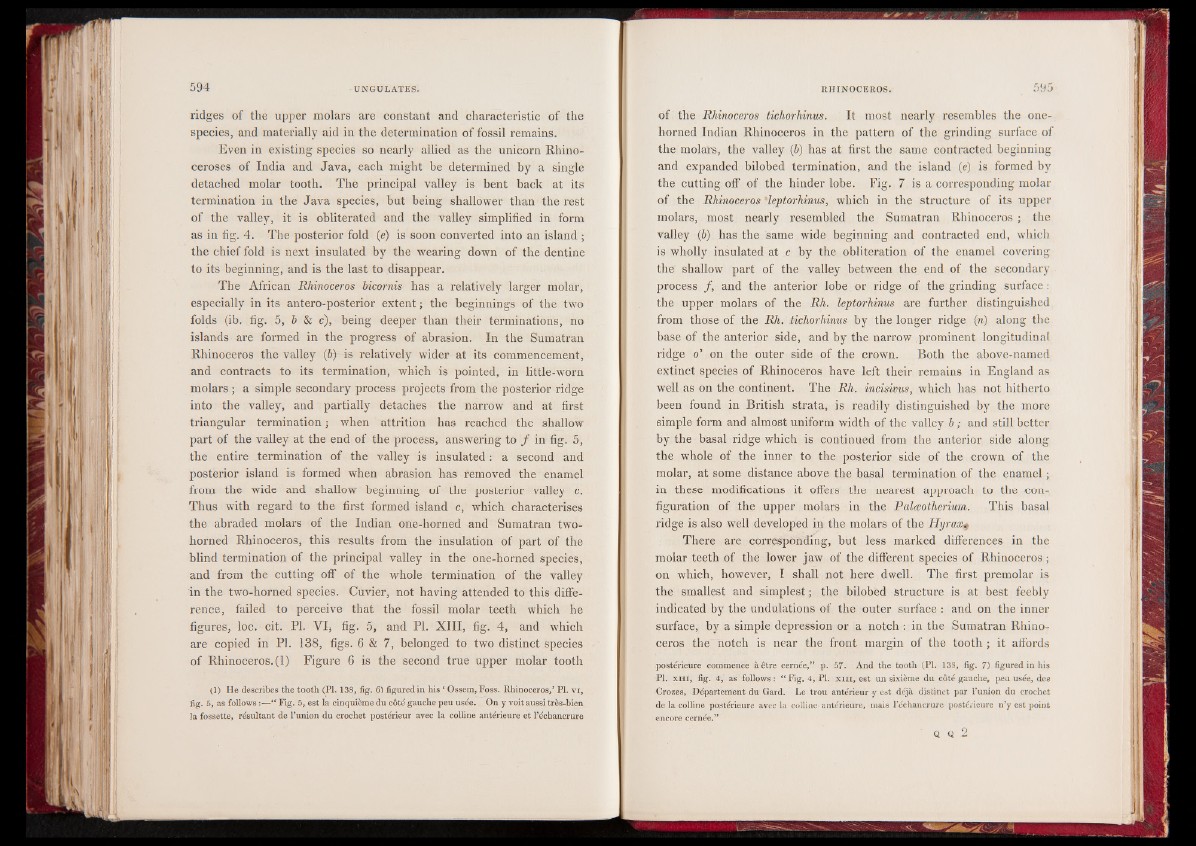
ridges of the upper molars are constant and characteristic of the
species, and materially aid in the determination of fossil remains.
Even in existing species so nearly allied as the unicorn Rhinoceroses
of India and Java, each might be determined by a single
detached molar tooth. The principal valley is bent back at its
termination in the Java species, hut being shallower than the rest
of the valley, it is obliterated and the valley simplified in form
as in fig. 4. The posterior fold (e) is soon converted into an island ;
the chief fold is next insulated by the wearing down of the dentine
to its beginning, and is the last to disappear.
The African Rhinoceros bicornis has a relatively larger molar,
especially in its antero-posterior extent ; the beginnings of the two
folds (ib. fig. 5, b & c), being deeper than their terminations, no
islands are formed in the progress of abrasion. In the Sumatran
Rhinoceros the valley (6) is relatively wider at its commencement,
and contracts to its termination, which is pointed, in little-worn
molars ; a simple secondary process projects from the posterior ridge
into the valley, and partially detaches the narrow and at first
triangular termination ; when attrition has reached the shallow
part of the valley at the end of the process, answering to ƒ in fig. 5,
the entire termination of the valley is insulated : a second and
posterior island is formed when abrasion has removed the enamel
from the wide and shallow beginning of the posterior valley c.
Thus with regard to the first formed island c, which characterises
the abraded molars of the Indian one-horned and Sumatran twohorned
Rhinoceros, this results from the insulation of part of the
blind termination of the principal valley in the one-horned species,
and from the cutting off of the whole termination of the valley
in the two-horned species. Cuvier, not having attended to this difference,
failed to perceive that the fossil molar teeth which he
figures, loc. cit. PI. VI* fig. 5, and PL XIII, fig. 4, and which
are copied in PI. 138, figs. 6 & 7, belonged to two distinct species
of Rhinoceros. (1) Figure 6 is the second true upper molar tooth 1
(1) He describes the tooth (PI. 138, fig. 6) figured in his ‘ Ossem, Foss. Rhinoceros,’ PI. vi,
fig. 5, as follows :—“ Fig. 5, est la cinquième du côté gauche peu usée. On y voit aussi très-bien
la fossette, résultant de l’union du crochet postérieur avec la colline antérieure et l’échancrure
of the Rhinoceros tichorhinus. It most nearly resembles the onehorned
Indian Rhinoceros in the pattern of the grinding surface of
the molars, the valley (b) has at first the same contracted beginning
and expanded bilohed termination, and the island (e) is formed by
the cutting off of the hinder lobe. Fig. 7 is a corresponding molar
of the Rhinoceros *leptorhinus, which in the structure of its upper
molars, most nearly resembled the Sumatran Rhinoceros ; the
valley (6) has the same wide beginning and contracted end, which
is wholly insulated at c by the obliteration of the enamel covering
the shallow part of the valley between the end of the secondary
process ƒ, and the anterior lobe or ridge of the grinding surface :
the upper molars of the Rh. leptorhinus are further distinguished
from those of the Rh. tichorhinus by the longer ridge (n) along the
base of the anterior side, and by the narrow prominent longitudinal
ridge o’ on the outer side of the crown. Both the above-named
extinct species of Rhinoceros have left their remains in England as
well as on the continent. The Rh. incisivus, which has not hitherto
been found in British strata, is readily distinguished by the more
simple form and almost uniform width of the valley b ; and still better
by the basal ridge which is continued from the anterior side along
the whole of the inner to the posterior side of the crown of the
molar, at some distance above the basal termination of the enamel ;
in these modifications it offers the nearest approach to the configuration
of the upper molars in the Palæotherium. This basal
ridge is also well developed in the molars of the Hyrax^
There are corresponding, hut less marked differences in the
molar teeth of the lower jaw of the different species of Rhinoceros ;
on which, however, I shall not here dwell. The first premolar is
the smallest and simplest ; the hilobed Structure is at best feebly
indicated by the undulations of the outer surface : and on the inner
surface, by a simple depression or a notch : in the Sumatran Rhinoceros
the notch is near the front margin of the tooth; it affords
postérieure commence à être cernée,” p. 57. And the tooth (PL 138, fig. 7) figured in his
PI. xiii, fig. 4, as follows : “ Fig. 4, PI. xm , est un sixième du côté gauche, peu usée, des
Crozes, Département du Gard. Le trou antérieur y est déjà distinct par l'union du crochet
de la colline postérieure avec la colline- antérieure, mais l’échancrure postérieure n’y est point